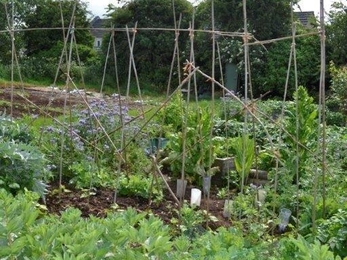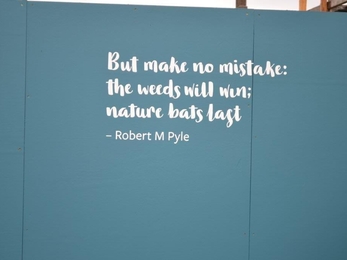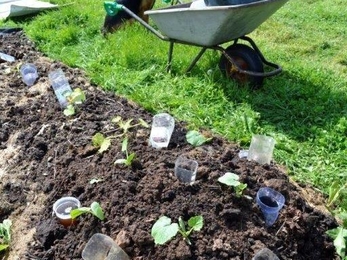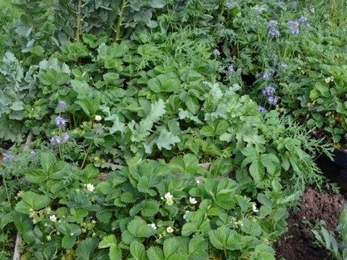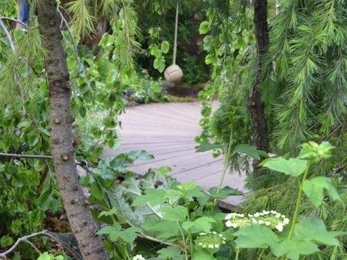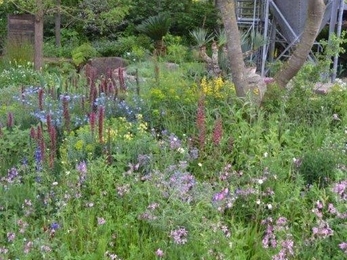The American ecologist and butterfly expert Robert Michael Pyle was spot on when he said: “But make no mistake: the weeds will win; nature bats last”… but are weeds such a bad thing?
June has got off to a damp start on Sue’s allotment, but there’s plenty to be cheerful about too.
On my allotment I try to grow fruit and vegetables in a way that works with nature: not everything is a rip roaring success, and my plot doesn’t always look as tidy as it might, but every now and again I see something that reaffirms my resolve to continue to garden in a way that’s wildlife friendly.
This week it’s blackfly on my broad beans, a sight that filled me with horror, especially as the crops in question were winter-sown and supposedly better placed to resist such invasions. A moment or so later my eyes alighted the scores of ladybirds that were climbing up the stalks ready to demolish the battalions of sap-sucking aphids.
During the dry weather I noticed quite a few of these jolly red beetles scurrying around on the surface of the soil, especially around areas of speedwell, groundsel and other ‘weeds’ that I hadn’t got around to pulling up.
Now they’re on the offensive, and with each ladybird capable of eating up to 5,000 aphids in its lifetime, I’m hopeful that the black fly won’t do too much damage. I’ll keep a close eye on their progress and pinch the tops out of my broad beans if it looks like the pest is getting the upper hand, but I’m quietly confident that my brave black-spotted warriors will do me proud.
While speedwell and groundsel may have worked in my favour, I’m keeping a close eye on the bindweed and goose grass (cleavers) that keep popping up around my raspberry canes. I repeat the mantra ‘weeds are persistent but not indestructible’ as I pull them up, hoping that my efforts will eventually weaken their resolve by preventing them from photosynthesising .
Chelsea style
The start of summer means there’s lots to do on the allotment, but May wasn’t all work and no play: The RHS Chelsea Flower Show took place during the third week of May and it was interesting to see how many designers are veering towards making gardens that are wildlife-friendly.
This was especially the case in the RHS Back to Nature Garden, co-designed by HRH the Duchess of Cambridge with Andrée Davies and Adam White.
This small area of woodland, complete with dens, rope swing and amazing ‘monster’s nest’ treehouse, highlighted the important role that nature can play in promoting physical and emotional wellbeing. It was a reminder, should one be needed, of the value in retreating to wild places, such as nature reserves, to play, learn and create family memories.
Another inspirational Chelsea space was The Resilience Garden, designed by Sarah Eberle, which explored how forest and landscapes can be helped as they face the threats posed by a changing climate, pests and diseases. Inspiration for the design came from Victorian horticulturalist William Robinson’s experimental approach to planting, which he pioneered on the Gravetye Estate in Sussex.
As Sarah Eberle wrote in the guidebook to this year’s RHS Chelsea Flower Show, “climate change is having a devastating impact on our natural environment, causing extreme weather and disrupting eco systems.
“Our trees and forests have a leading role to play in our future, but we have to take care of them.”
Smelling of roses
We have two trees on the allotment: a self-seeded crack willow that we endeavour to keep under control with winter haircuts and a fig, planted on the sunny side of the shed. This year is looking very promising in terms of getting our first fig harvest, with large fruits growing plumper by the day.
Next to the fig is a small plastic-covered ‘greenhouse’ in which I’m growing a few tomatoes. If we get a warm summer I may end up with a decent harvest, but I’m not discounting the possibility of blight creeping in if we get a lot of warm weather. It’s a gamble, but the thought of sweet-tasting sun-ripened tomatoes is spurring me on.
The allotment roses are coming into bloom, adding a great splash of colour to the top end of the plot. These plants are now quite well established and appear to benefit from their rations of chicken manure pellets topped off with a compost mulch late in the year.
More colour is provided by the phacelia, which is a-buzz with honey and bumble bees of all descriptions. These insects are also keen on the strawberry flowers, something I’ll need to keep in mind as I pick my first crops over the next few days.
All in all a busy time is approaching, but during the intense activity I’ll do my best to make time to stop and take the occasional look around to see what I’m sharing with the insects, birds, mammals and amphibians for which it’s a home and a larder.

